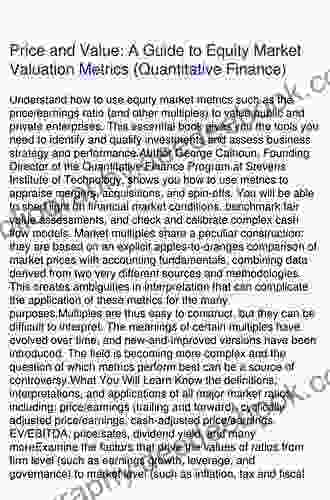A Comprehensive Guide to Equity Market Valuation Metrics in Quantitative Finance

Equity market valuation metrics are essential tools for investors and financial analysts to assess the intrinsic value of a company. They provide insights into a company's financial performance, growth potential, and risk profile. In this article, we will explore the most commonly used equity market valuation metrics and discuss their applications in quantitative finance.
The price-to-earnings (P/E) ratio is a widely used metric that measures the relationship between a company's market price per share and its earnings per share (EPS). It provides an indication of how much investors are willing to pay for each dollar of a company's earnings.
A high P/E ratio may indicate that the market is valuing the company's future earnings growth potential, while a low P/E ratio may suggest that the market believes the company is undervalued. However, it is important to consider industry peers and overall market conditions when interpreting the P/E ratio.
4.3 out of 5
| Language | : | English |
| File size | : | 31128 KB |
| Text-to-Speech | : | Enabled |
| Screen Reader | : | Supported |
| Enhanced typesetting | : | Enabled |
| Word Wise | : | Enabled |
| Print length | : | 513 pages |
The price-to-book (P/B) ratio compares a company's market price per share to its book value per share. Book value represents the net worth of a company based on its assets and liabilities.
A high P/B ratio may indicate that the market is valuing the company's intangible assets, such as brand recognition or intellectual property, while a low P/B ratio may suggest that the company is undervalued. However, it is important to consider the industry and accounting practices when interpreting the P/B ratio.
The price-to-sales (P/S) ratio measures the relationship between a company's market price per share and its revenue per share. It provides an indication of how much investors are willing to pay for each dollar of a company's revenue.
A high P/S ratio may indicate that the market is valuing the company's growth potential or market share, while a low P/S ratio may suggest that the company is undervalued. However, it is important to consider industry dynamics and the company's competitive landscape when interpreting the P/S ratio.
Dividend yield measures the annual dividend per share as a percentage of the market price per share. It provides an indication of the income return investors can expect from a company's stock.
A high dividend yield may be attractive to investors seeking income, while a low dividend yield may indicate that the company is reinvesting its earnings for future growth. However, it is important to consider the sustainability of the dividend yield and the company's overall financial health when evaluating this metric.
Earnings per share (EPS) measures the net income of a company divided by the number of outstanding shares. It represents the portion of the company's profits that is attributable to each share of stock.
EPS is a key metric for assessing a company's profitability and is often used as the basis for other valuation metrics, such as the P/E ratio. However, it is important to consider the impact of non-recurring items, such as one-time gains or losses, on EPS.
Return on equity (ROE) measures the return that a company generates on the equity invested by its shareholders. It is calculated by dividing net income by shareholders' equity.
ROE provides an indication of how efficiently a company is using its capital to generate profits. A high ROE may indicate that the company is generating a high return on its investments, while a low ROE may suggest that the company is not using its capital effectively.
The debt-to-equity ratio measures the amount of debt a company has relative to its shareholders' equity. It provides an indication of the company's financial leverage and risk profile.
A high debt-to-equity ratio may indicate that the company is using a significant amount of debt to finance its operations, which can increase its financial risk. A low debt-to-equity ratio may indicate that the company has a conservative financial approach and is less risky.
Equity market valuation metrics are used extensively in quantitative finance for various applications, including:
Portfolio Management: Valuation metrics help investors and portfolio managers assess the value and risk of potential investments and allocate capital accordingly.
Security Analysis: Analysts use valuation metrics to evaluate the intrinsic value of companies and make investment recommendations.
Risk Management: Valuation metrics can be used to assess the risk profile of individual securities or portfolios and develop appropriate risk management strategies.
Financial Modeling: Valuation metrics are used as inputs in financial models to forecast future financial performance and value companies.
Corporate Finance: Valuation metrics are essential for decision-making in corporate finance transactions, such as mergers and acquisitions, and capital raising.
Equity market valuation metrics are powerful tools that provide valuable insights into the financial performance, growth potential, and risk profile of companies. By understanding and applying these metrics, investors and financial analysts can make informed investment decisions and navigate the equity markets effectively. It is important to note that no single metric can provide a complete picture of a company's value, and a combination of metrics should be considered along with other qualitative and quantitative factors.
4.3 out of 5
| Language | : | English |
| File size | : | 31128 KB |
| Text-to-Speech | : | Enabled |
| Screen Reader | : | Supported |
| Enhanced typesetting | : | Enabled |
| Word Wise | : | Enabled |
| Print length | : | 513 pages |
Do you want to contribute by writing guest posts on this blog?
Please contact us and send us a resume of previous articles that you have written.
 Book
Book Novel
Novel Page
Page Story
Story Genre
Genre Reader
Reader Paperback
Paperback E-book
E-book Magazine
Magazine Newspaper
Newspaper Paragraph
Paragraph Sentence
Sentence Bookmark
Bookmark Glossary
Glossary Bibliography
Bibliography Foreword
Foreword Preface
Preface Bestseller
Bestseller Classics
Classics Narrative
Narrative Memoir
Memoir Encyclopedia
Encyclopedia Thesaurus
Thesaurus Narrator
Narrator Character
Character Card Catalog
Card Catalog Stacks
Stacks Research
Research Scholarly
Scholarly Reserve
Reserve Academic
Academic Journals
Journals Rare Books
Rare Books Interlibrary
Interlibrary Thesis
Thesis Dissertation
Dissertation Reading List
Reading List Book Club
Book Club Theory
Theory Textbooks
Textbooks Scarlett Se Leva
Scarlett Se Leva Sudipta Kaviraj
Sudipta Kaviraj Eric J Gates
Eric J Gates Angelica Morrone
Angelica Morrone Keith Sweat
Keith Sweat Petru Popescu
Petru Popescu Anit Korpal
Anit Korpal Nicholas Baragwanath
Nicholas Baragwanath Jeffrey P Crouch
Jeffrey P Crouch Meredith Colby
Meredith Colby Victoria Kennefick
Victoria Kennefick W Chan Kim
W Chan Kim Kelly Barnhill
Kelly Barnhill Anil Nanda Md Mph Facs
Anil Nanda Md Mph Facs Lisa Jacobs
Lisa Jacobs Shirley Jordan
Shirley Jordan Sally Engle Merry
Sally Engle Merry Luther Standing Bear
Luther Standing Bear Prateek Joshi
Prateek Joshi Sarah Graley
Sarah Graley
Light bulbAdvertise smarter! Our strategic ad space ensures maximum exposure. Reserve your spot today!

 Billy PetersonUnraveling the Enigmatic Country House Mystery of the 1920s: The Mr. Quayle...
Billy PetersonUnraveling the Enigmatic Country House Mystery of the 1920s: The Mr. Quayle... Melvin BlairFollow ·5.4k
Melvin BlairFollow ·5.4k Bernard PowellFollow ·4k
Bernard PowellFollow ·4k Earl WilliamsFollow ·18.4k
Earl WilliamsFollow ·18.4k Jaime MitchellFollow ·13.7k
Jaime MitchellFollow ·13.7k Gene SimmonsFollow ·2.8k
Gene SimmonsFollow ·2.8k Ian McEwanFollow ·19.7k
Ian McEwanFollow ·19.7k Gus HayesFollow ·10.8k
Gus HayesFollow ·10.8k Jules VerneFollow ·7.5k
Jules VerneFollow ·7.5k

 Braden Ward
Braden WardFeminism's Forgotten Fight: The Ongoing Battle for...
The feminist movement has historically...

 Julio Cortázar
Julio CortázarBlue Heaven Black Night: A Literary Journey Through Love,...
In the realm of...

 Eddie Bell
Eddie BellA Journey Through Time: Exploring the Enchanting World of...
The vibrant tapestry of New...

 Lawrence Bell
Lawrence BellValiance Dragon Soul Press Anthology: A Literary Odyssey...
Step into a realm where...

 Aron Cox
Aron CoxEmbark on a Creative Odyssey with Jean Leinhauser's "101...
Unveil a Kaleidoscope of...
4.3 out of 5
| Language | : | English |
| File size | : | 31128 KB |
| Text-to-Speech | : | Enabled |
| Screen Reader | : | Supported |
| Enhanced typesetting | : | Enabled |
| Word Wise | : | Enabled |
| Print length | : | 513 pages |












